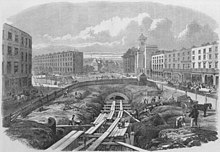Sir John Fowler, 1st Baronet
Fowler initially established a practice as a consulting engineer in the Yorkshire and Lincolnshire area, but, a heavy workload led him to move to London in 1844.
Constructed in shallow "cut-and-cover" trenches beneath roads, the line opened between Paddington and Farringdon in 1863.
Although some of this would have been passed on to staff and contractors, Sir Edward Watkin, chairman of the Metropolitan Railway from 1872, complained that "No engineer in the world was so highly paid.
[6] Fowler's consulting work extended beyond Britain including railway and engineering projects in Algeria, Australia, Belgium, Egypt, France, Germany, Portugal and the United States.
He travelled to Egypt for the first time in 1869 and worked on a number of, mostly unrealised, schemes for the Khedive,[1] including a railway to Khartoum in Sudan which was planned in 1875 but not completed until after his death.
[1] The commission recommended a steel cantilever bridge designed by Fowler and Benjamin Baker, which was constructed between 1883 and 1890.
To avoid problems with smoke and steam overwhelming staff and passengers on the covered sections of the Metropolitan Railway, Fowler proposed a fireless locomotive.
The boiler had a normal firebox connected to a large combustion chamber containing fire bricks which were to act as a heat reservoir.
The locomotive was intended to operate conventionally in the open, but in tunnels dampers would be closed and steam would be generated firelessly, using the stored heat from the fire bricks.
The locomotive was sold to Isaac Watt Boulton in 1865; he intended to convert it into a standard engine but it was eventually scrapped.
[12] While they were not fireless, the locomotives condensed their steam, and burnt coke or smokeless coal to reduce smoke emitted.
[13] He built the substantial Braemore House (since demolished), where he entertained at the highest levels of politics and society.
He developed a hydro-electric scheme, fed from the artificial Home Loch, planted extensive woodlands on the steep valley sides, and created 12 km of recreational walks through them, including suspension footbridges over the Corrieshalloch and Strone Gorges (the former now an NTS property).
[1][20] Along with Benjamin Baker, he received an honorary degree of Doctor of Laws from the University of Edinburgh in 1890 for his engineering of the bridge.




